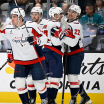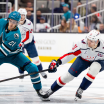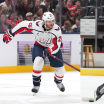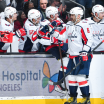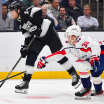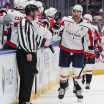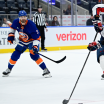Just Adjust – Now that Game 1 is in the rear view comes the series of adjustments we expect from both sides as the two clubs parry back and forth to try to swing the series in their favor. The Caps loved their start in Game 1, and Montreal loved its finish. But both sides are still seeking to impose their will and their stamp on the games and the series.
“I thought in the first period they came out flying,” said Montreal defenseman Kaiden Guhle, in the wake of Game 1. “Obviously, there was a lot of energy in the building. The second period was kind of even, I thought, and in the third period we just took over.”
“I think it shows what kind of team we can be,” said Caps right wing Tom Wilson of his team’s Game 1 start. “And we really proved it to ourselves in the first little bit of that game, how effective we can be – physical, fast, simple – putting pucks in behind their [defense].
“And I think you see the game turn a little bit when we stop doing that stuff. So we know the blueprint, we know the recipe, and we’ve just got to be a little more consistent with it, no matter what the circumstances out there.”
Working Late – One of Washington’s top tasks in this series is trying to limit the damage that Montreal’s top line of Cole Caufield, Nick Suzuki and Juraj Slafkovsky is capable of inflicting.
On Tuesday, Caps coach Spencer Carbery made note of the fact that Montreal’s top line tends to take longer shifts when they’re able to establish offensive zone possession, which helps them exact a toll on the line – or lines – and the blueline pairing they’re going up against at any given time. Today, he went a bit more in depth on the topic.
“I thought it was okay,” says Carbery of his team’s Game 1 play against the Suzuki line. “Their [possession] numbers are high, and I will say this, too. Going back through the game, the narrative is this, two things: Suzuki’s line has a significant advantage expected goals wise, and also the third period looks like a very lopsided period as well, for Montreal.
“But if you go back through the film, our third period, the first 10 minutes was excellent. We get the first five chances of that period, so we out-chance them like 5-0 through maybe the first eight minutes of the period. So we’re going. The penalty [on P-L Dubois at 10:03 of the third] – and the goal thereafter – changes the momentum of the game, which can happen in the playoffs; the margins are thin.”
Entering the third period of Game 1, naturalstattrick.com had the Caps with a 19-11 lead in scoring chances and an 11-3 advantage in high danger scoring chances. Washington mostly ran up those margins in the first 20 minutes; as Guhle said, the second was fairly even.
But as for Guhle’s comment about the Habs taking over in the third, Carbery is correct. The Caps had the better of the first 10 minutes or so, right up to the Dubois penalty. That’s when Montreal began to seize momentum, doing so when a seam pass from Patrik Laine didn’t reach its intended destination, but instead took a favorable bounce off a skate blade to Caufield in the slot. He doesn’t miss from there.
Washington outshot Montreal 7-2 in the third, right up to the moment of the Dubois penalty. The Habs blanked the Caps 12-0 in shots on net the rest of the way, including the power play that produced the Caufield goal.
“And that one shift that they score [the tying goal at 15:45] makes their numbers go through the roof,” says Carbery. “They had like maybe eight or nine shot attempts in that one sequence, and then they get four – I think – Grade A’s in that one sequence. You take that one shift out of there, now, it’s a big shift. They score there, they generate a ton of activity at our net, they have two lines hemmed, and it’s what I talked about the other day.
“Something we are going to have to get comfortable with is that line plays long shifts; those guys have engines. And what I mean by that is they played through two [Washington] lines in that shift. So it goes for 45 seconds, whoever is out against them, [Nic] Dowd’s line or Dubois’ line. Dubie has already changed by then, and so now you’ve got people coming on and [the Canadiens] are still countering and going quick up [the ice]. And they’re able to sustain that pace of play.”
The Suzuki trio had been on the ice for 65 seconds by the time the tying goal was scored. And as lethal as that trio can be, it is even more so when Lane Hutson is on the ice with them, which he was. Hutson’s shift was 1:33.
“It’s something that we have to be aware of,” says Carbery. “If they’re going to take a minute or a minute and 20 seconds shifts with their top line, we have to be able to stay dialed in with multiple lines, not just one line that is going to be able to match up and handle them, so I thought that played a role in that sequence there in the third period that ties the game.”
Over the course of the 2024-25 regular season, all three players rank among the NHL’s top 30 among average shift length of forwards around the circuit. Suzuki averaged 57 seconds per shift in the regular season while Caufield and Slafkovsky came in at 55 seconds per shift.
Looking at the top 30 in that category, it’s clear to see that the top lines of both Minnesota and Edmonton operate with a similar philosophy. Each of those Western Conference clubs has each of its top line players firmly entrenched on that list, with Minnesota doing so to the extreme; four of the top five slots on the list are occupied by Wild forwards: Kirill Kaprizov (1:05), Mats Zuccarello (1:03), Matt Boldy (1:01) and Marco Rossi (:59). Edmonton’s Connor McDavid (1:03) is the only non-Minnesota forward in the top five.
Miss You – The Caps will be playing without blueliner Martin Fehervary (lower body) for the rest of the playoffs, and as we noted yesterday, Fehervary is one of only 14 defensemen (60 or more games) who averaged five or more hits and five or more blocked shots per 60 minutes. But even drilling down on that list, it’s clear how much value Fehervary delivers compared to the rest.
Although his nightly average of 19 minutes in ice time ranks seventh among the 14, Fehervary’s five goals ranks fourth, and his 25 points is third most on the list. His plus-18 is tied (with Calgary’s MacKenzie Weegar) for the best among the bunch, and perhaps most significantly, Fehervary’s average of 3:02 in shorthanded ice time is not only tops among this group, but he ranks sixth in the NHL among all defenseman and was Washington’s team leader in that department this season.
Washington is fortunate to have 35-year-old John Carlson still playing at the top of his game; Carlson’s 2:51 in average shorthanded ice time ranked 12th among NHL defensemen this season, and only one of the 11 players ahead of him on the list – Utah’s Mikhail Sergachev (3:02) was able to join Carlson in racking up 50 or more points this season.
Among the rest of the regular Washington blueline brigade, Matt Roy’s average of 1:45 in shorthanded ice time ranked 84th, Trevor van Riemsdyk’s 1:34 placed him 96th and Rasmus Sandin’s 37 seconds ranked 133rd.
As far as filling in for the left-handed Fehervary’s absence, it sounds like the Caps will lean on their three righties – Carlson, Roy and van Riemsdyk – to shoulder the shorthanded workload rather than their three healthy lefties, including Alex Alexeyev, who is taking Fehervary’s place in the Washington lineup.
“I know [Alexeyev] can do it, and we can put him in those situations if need be,” says Carbery. “But I think more of the workload penalty kill wise will rest on Matt Roy, Sandin, Trevor van Riemsdyk. John already plays a significant amount of minutes in that role. I think it will be shared amongst those guys, not to say that Al won’t get an opportunity to get out there and do it.
“But I think this will now bump Matt Roy to where he is first over the boards, as Marty was before. It’s two righties, which changes the mix a little bit, but it’s something that Matt Roy is absolutely capable of excelling in that role, without a doubt.”
During his days in Los Angeles, Roy routinely logged more shorthanded time than he has in this, his first season as a Capital. He led the Kings with 2:51 last season, and he was the Los Angeles leader in that department in three of his last four seasons with the club.
And back in 2021-22, van Riemsdyk led Washington blueliners with an average of 2:39 in shorthanded ice time, and he repeated the feat the following season with 2:35.
Among the Caps’ current left-side defensemen, Jakob Chychrun isn’t deployed on the PK and Sandin’s average of 37 seconds this season easily represents his career high. Alexeyev’s playing time has been so sporadic this season that it seems unlikely he will be deployed in such situations unless there is a pressing need. Back in 2022-23 when he was seeing more regular duty, Alexeyev did average 1:07 shorthanded ice time across 32 games of work.
“It’s something we’ve been talking about,” says Sandin, “drawing in a little bit – or a bunch – for [Fehervary] there. Marty is such a big piece of this team, in the way he contributes, especially with blocking shots and playing a really, really good defensive game for us, and also producing a little bit of offense this year. He is a huge piece of our team.
“So missing him a big loss, but it's up the rest of us other defensemen to fill in for him. And I think in that way, maybe my role changes a little bit too, stepping in for Marty a little bit, and playing a little bit of a different game. But it’s something we all have to be ready for. In the playoffs, sometimes a lot of bodies can go down, so I think everyone has to ready in every single role.”
As for Alexeyev, he has enough going with adjusting to the new landscape inside his mouth. After taking a Jake Evans stick blade square in the mouth in Game 1 – on a follow through from the Habs’ center – Alexeyev lost three upper teeth and had three lowers get chipped. He was in the dentist’s chair until the wee hours of Tuesday morning getting repairs, though the heavy work of restoring his choppers will wait until the offseason.
Meanwhile, Alexeyev is smiling through his new fishbowl helmet, appearing to all the world to be happier being in the lineup than he is disappointed at the loss of about 10 percent of his chiclet allotment.
“It’s fun man, it’s fun,” he says. “It’s a different mentality. It’s just great. It’s a great atmosphere; fans are doing a great job. It’s fun.”
In The Nets – Washington’s Logan Thompson and Montreal’s Sam Montembeault both acquitted themselves well in Monday night’s series opener, and both made key stops throughout the contest.
Tonight, both goalies seek to build on that body of work in their unique situations. Thompson’s Game 1 start was his first appearance since he suffered an upper body injury in an April 2 game at Carolina.
Meanwhile, Montembeault has been the League’s busiest goalie for the last month plus. Including his Game 1 starting assignment, he has started 15 of the Habs’ last 18 games. From March 15 to season’s end, no NHL netminder logged more minutes in the crease (841:14) than Montembeault.
All Lined Up – Here’s how the Capitals and the Canadiens might look in Wednesday night’s Game 2 of the best-of-seven set between the two teams:
WASHINGTON
Forwards
8-Ovechkin, 17-Strome, 72-Beauvillier
24-McMichael, 80-Dubois, 43-Wilson
88-Mangiapane, 20-Eller, 9-Leonard
22-Duhaime, 26-Dowd, 16-Raddysh
Defensemen
6-Chychrun, 74-Carlson
3-Roy, 38-Sandin
27-Alexeyev, 57-van Riemsdyk
Goaltenders
48-Thompson
79-Lindgren
Extras
25-Bear
33-Stevenson
52-McIlrath
53-Frank
Out/Injured
15-Milano (upper body)
19-Backstrom (hip)
21-Protas (lower body)
42-Fehervary (lower body)
77-Oshie (back)
MONTREAL
Forwards
13-Caufield, 14-Suzuki, 20-Slafkovsky
11-Gallagher, 28-Dvorak, 17-Anderson
92-Laine, 15-Newhook, 93-Demidov
51-Heineman, 71-Evans, 40-Armia
Defensemen
8-Matheson, 45-Carrier
21-Guhle, 48-Hutson
47-Struble, 58-Savard
Goaltenders
35-Montembeault
75-Dobes
Extras
55-Pezzetta
72-Xhekaj
91-Kapanen
Out/Injured
31-Price (lower body)
77-Dach (lower body)









